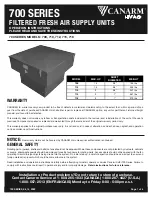
DUCTING
Airflow Balancing
Volume-balanced airflow in the ventilator is required. Volume of outside air brought in must equal the volume of
air the unit exhausts. If airflow is not correctly balanced:
unit does not operate at its maximum efficiency.
•
negative or positive air pressure can occur in the house.
•
unit will not defrost properly.
•
warranty can be voided.
•
Excessive positive pressure
can drive moist indoor air into building external walls where it can condense (in cold
weather) and degrade structural components. Moist indoor air can also cause keyholes to freeze.
Excessive negative pressure
can have several undesirable side effects; in some geographic locations, soil
gases such as methane and radon can be drawn into the home through basement/ground contact areas.
Excessive negative pressure can also cause back drafting of vented combustion equipment when adequate
combustion air supply is not provided.
Balancing Procedure
Six-inch (150 mm) diameter flow collars connected to inclined or digital manometer, or magnehelic, with
range of 0 to.25 in. (0 to 62.5 Pa) of water are recommended for accurate airflow measurements. To avoid
airflow turbulence and incorrect readings, flow stations should be located at a distant point of at least five duct
diameters; for example, 6 in. (150 mm) duct requires five diameters x 6 in. (150 mm) = 30 in. (76 cm) from
nearest valve or flow restriction. This requirement applies to both stale air to exchanger duct and fresh air to
house duct.
Before balancing, make sure:
all sealing of the ductwork system is completed.
•
all of the ventilator system components are in place and functioning properly.
•
balancing dampers are fully open.
•
unit is on High speed.
•
airflows in branch lines to specific areas of house are adjusted before balancing the unit. (A smoke pencil
•
used at the grilles is a good indicator of relative airflow for each branch line.)
HVAC fan is on for models ducted into HVAC system.
•
PUSH AND TURN WITH
SLOTTED SCREWDRIVER.
DAMPER AUTOMATICALLY
LOCKS WHEN PRESSURE
IS RELEASED.
M13462
Balancing airflow.
Fig. 20.
After taking readings in stale air and fresh air ducts,
duct with lower cfm (L/s) velocity reading should
remain as is, while duct with higher reading should be
dampered back to match lower reading. See Fig. 20.
Return unit to appropriate fan speed for normal
operation.
HR150, 200; ER150, 200 Perfect Window™ Fresh Air Ventilation Systems 68-0171—12
16











































